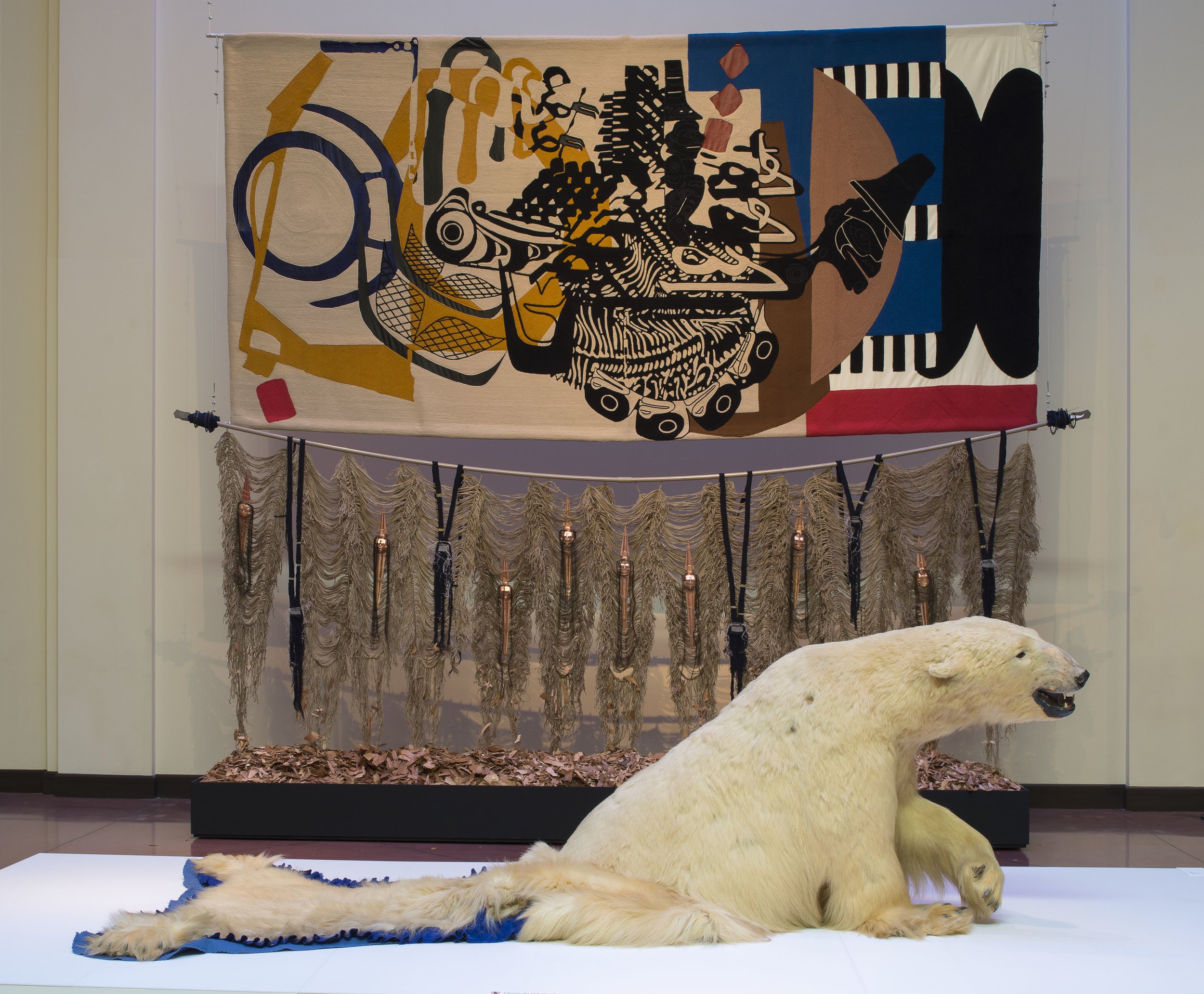Your Last Chance to See “Dear Listener: Works by Nicholas Galanin,” at Phoenix’s Heard Museum
During the month of August, I conducted research at the Heard Museum and had the opportunity to see this outstanding retrospective, which will be on view only until Monday, September 3rd! If in Phoenix, Arizona, go see this! If not, below is a sneak peek, including an interview with the artist himself, phenomenal images provided by the Heard Museum, and several links to learn more about the multidisciplinary work of Nicholas Galanin.
"Dear Listener: Works by Nicholas Galanin," at the Heard Museum. All images provided by the Heard Museum.
Nicholas Galanin, a Tlingit/Unangax̂/ Multi-Disciplinary artist who currently lives in Sitka, Alaska, has been described by the New York Times as a “standout” artist in the contemporary art world. His retrospective, Dear Listener: Works by Nicholas Galanin, exhibited at the Heard Museum is a fierce clapback at the face of Empire (for this metaphor, I thank Alan C. Palaez Lopez, who coined the term during a workshop at the Indigenous Americas Working Group at UCBerkeley in 2017). Through his work, Galanin sends out a ringing sound wave, directly addressing his audience:
“Dear Listener," he writes, "My work is a sovereign creation as communication, transmission of knowledge and continuum that has existed since time immemorial. I continue the cultures I descend from and live within, listening and contributing thanks to the teachers who have shown me good ways to follow. . . . You signal your coordinates, I signal mine with this work. . . .
Gunalchéesh”
We Dreamt Deaf, polar bear taxidermy, 2015 | Axes in Polyrhuthm, When My Drums Come Knocking They Watch, wood, cotton, silk, jute, woodchips, collaboration with Nep Sidhu, 2018.
The opening piece to the exhibition, a polar bear taxidermy that vanishes before our eyes (We Dreamt DEAF, 2015) is flanked by the monumental collaboration with Nep Sidhu, Axes in Polyrhythm, When My Drums Come Knocking They Watch (2018), setting the tone and ushering us viewers into a space that is as ground shaking as it is integrative.
God Complex, glazed porcelain, 2015.
One of his ceramic sculptures, God Complex, features the all-white riot gear of a police officer, which assumes the posture of the crucified Christ. His is a visual commentary on militarization, securitization, and police brutality against Native Americans and other POC. God Complex exposes and criticizes the prison-industrial complex, which continues to profit at the expense of incarcerated BIPOC.
A Supple Plunder, ballistic torsos, two-chanel video, collaboration with Jerrod Galanin, 2015-2018.
The exhibition also includes works such as A Supple Plunder (2015-2018), a collaboration with his brother Jerrod Galanin, using the pseudonym Leonard Getinthecar. The nine ballistic torsos and two-channel video honor the twelve Unangan men who were bound together by Russian invaders and were experimentally shot to see how many human beings could be killed with a single bullet. As an anti-monument, this work marks and remembers the deaths endured by Indigenous people.
White Noise, American Prayer Rug, wool, cotton, 2018.
The prayer rug White Noise (2018), the Imaginary Indian, Totem (2016), the US flag and ammunition The American Dream Is Alie and Well (2012), the male performer White Carver (2012-present), the Indian Children’s Bracelet (2014) all denounce the colonial project while honoring and celebrating the cultural agency sustained by his community.
Imaginary Indian, Totem, wood, floral wallpaper, paint, abalone shells, 2016.
White Carver, velvet rope, wood stump, wooden platform, white male performer, 2012-present.
Indian Children's Bracelet, had-engraved iron, 2014.
Galanin's works confront the brutality of the American colonial desire while denouncing the ways in which cultural theft is institutionalized, packaged, and sold for consumption. They also provide a strategic tactic of “Survivance.” reinserting Indigenous art as equals in the cultural production of this country.
The American Dream is Alie and Well, U.S. flag, .50-caliber ammunition, foam, gold leaf, plastic, 2012.
Working across mediums, geographies, and generations, Galanin demonstrates how Indigenous bodies, land, and cultures have been "handled," “contained,” and essentialized as a function of white supremacy and colonialism. The artist's oeuvre demonstrates that to decolonize (in the context of art institutions) entails the sharing of power, visibility, and authority with colonized subjects. “Culture,” he writes, “is rooted in connection to the land; like land, culture cannot be contained. I am inspired by generations of Tlingit & Unangax̂ creative production and knowledge connected to the land I belong to.”
What Have We Become?, 2017.
Galanin understands his work as engaging across cultures in a continuum that resists romanticization, categorization, and limitation of the Indigenous subject. He explains that he uses his work “to explore adaptation, resilience, survival, active cultural amnesia, dream, memory, cultural resurgence, connection to and disconnection from the land.” Galanin also believes that it is through the passing of this art practice and knowledge to his apprentices that his culture will continue to hold the keys to creative sovereignty and “reject the dehumanizing erasure of Indigenous knowledge, land, and culture, all of which are interwoven genocide.”
Creation with Her Children, collaboration with Merritt Johnson, 2017.
Dear Listener runs through September 3rd, 2018 and can be visited Mondays to Saturdays from 9:30am to 5pm and Sundays from 11am to 5pm. The Heard Museum, which is committed to advancing American Indian Art, is located at 2301 North Central Avenue in Phoenix, AZ 85004. If you can’t make it to the exhibition but would like to learn more about it, you can purchase the excellent catalog here (which includes a vinyl from the artist’s band Indian Agent!). Lastly, a resounding OBRIGADA to Nicholas Galanin for generously agreeing to be interviewed on August 20th, 2018.
Em Resistência,
Yohana A. Junker
She in Constellation Medicine Form, No Pigs in Paradise, Series, 2, Collaboration with Nep Sidhu, created under the collective Black Constellation, 2018.












